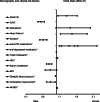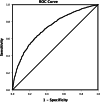Gender differences in comorbidities and risk factors in ischemic stroke patients with a history of atrial fibrillation
- PMID: 34034655
- PMCID: PMC8146651
- DOI: 10.1186/s12883-021-02214-8
Gender differences in comorbidities and risk factors in ischemic stroke patients with a history of atrial fibrillation
Abstract
Background: Atrial Fibrillation (AF) is a common cardiac arrhythmia and has been identified as a major risk factor for acute ischemic stroke (AIS). Gender differences in the disease process, causative mechanisms and outcomes of AF have been investigated. In the current study, we determined whether there is a gender-based disparity in AIS patients with baseline AF, and whether such a discrepancy is associated with specific risk factors and comorbidities.
Methods: Baseline factors including comorbidities, risk and demographic factors associated with a gender difference were examined using retrospective data collected from a registry from January 2010 to June 2016 in a regional stroke center. Univariate analysis was used to differentiate between genders in terms of clinical risk factors and demographics. Variables in the univariate analysis were further analyzed using logistic regression. The adjusted odds ratios (ORs) and 95% confidence intervals (CIs) for each factor were used to predict the increasing odds of an association of a specific comorbidity and risk factor with the male or female AIS with AF.
Results: In the population of AIS patients with AF, a history of drug and alcohol use (OR = 0.250, 95% CI, 0.497-1.006, P = 0.016), sleep apnea (OR = 0.321, 95% CI, 0.133-0.777, P = 0.012), and higher serum creatinine (OR = 0.693, 95% CI, 0.542-0.886 P = 0.003) levels were found to be significantly associated with the male gender. Higher levels of HDL-cholesterol (OR = 1.035, 95% CI, 1.020-1.050, P < 0.001), LDL-cholesterol (OR = 1.006, 95% CI, 1.001-1.011, P = 0.012), and the inability to ambulate on admission to hospital (OR = 2.258, 95% CI, 1.368-3.727, P = 0.001) were associated with females.
Conclusion: Our findings reveal that in the AIS patients with atrial fibrillation, migraines, HDL, LDL and poor ambulation were associated with females, while drugs and alcohol, sleep apnea, and serum creatinine level were associated with male AIS patients with AF. Further studies are necessary to determine whether gender differences in risk factor profiles and commodities require consideration in clinical practice when it comes to AF as a risk factor management in AIS patients.
Keywords: Acute ischemic stroke; Atrial fibrillation; Demographics; Gender; Risk factors.
Conflict of interest statement
None.
Figures






Similar articles
-
Plasma D-dimer level is associated with clinical outcomes in patients with atrial fibrillation related acute ischemic stroke after pneumonia.BMC Neurol. 2021 Mar 27;21(1):137. doi: 10.1186/s12883-021-02168-x. BMC Neurol. 2021. PMID: 33773590 Free PMC article.
-
Initial Stroke Severity in Patients With Atrial Fibrillation According to Antithrombotic Therapy Before Ischemic Stroke.Stroke. 2020 Sep;51(9):2733-2741. doi: 10.1161/STROKEAHA.120.030138. Epub 2020 Aug 19. Stroke. 2020. PMID: 32811392
-
Risk factors for poor outcome and mortality at 3 months after the ischemic stroke in patients with atrial fibrillation.J Stroke Cerebrovasc Dis. 2013 Nov;22(8):e419-25. doi: 10.1016/j.jstrokecerebrovasdis.2013.04.025. Epub 2013 May 28. J Stroke Cerebrovasc Dis. 2013. PMID: 23721617
-
The role of artificial intelligence in optimizing management of atrial fibrillation in acute ischemic stroke.Ann N Y Acad Sci. 2024 Nov;1541(1):24-36. doi: 10.1111/nyas.15231. Epub 2024 Oct 8. Ann N Y Acad Sci. 2024. PMID: 39377991 Review.
-
Atrial fibrillation-related ischemic stroke and cognitive impairment: Research progress on the characteristics and pathogenesis.Brain Res Bull. 2025 Jul;227:111392. doi: 10.1016/j.brainresbull.2025.111392. Epub 2025 May 20. Brain Res Bull. 2025. PMID: 40403935 Review.
Cited by
-
A retrospective study on sex disparities and risk factors in acute ischemic stroke in the West bank of Palestine.Sci Rep. 2025 May 8;15(1):16135. doi: 10.1038/s41598-025-01268-9. Sci Rep. 2025. PMID: 40341166 Free PMC article.
-
Sex differences in clinical risk factors in obese ischemic stroke patients with a history of smoking.BMC Cardiovasc Disord. 2024 May 30;24(1):288. doi: 10.1186/s12872-024-03952-6. BMC Cardiovasc Disord. 2024. PMID: 38816791 Free PMC article.
-
Age Stratification in Acute Ischemic Stroke Patients with Heart Failure.J Clin Med. 2022 Dec 21;12(1):38. doi: 10.3390/jcm12010038. J Clin Med. 2022. PMID: 36614839 Free PMC article.
-
Sex Differences in Severity and Risk Factors for Ischemic Stroke in Patients With Hyperlipidemia.Neurosci Insights. 2024 May 3;19:26331055241246745. doi: 10.1177/26331055241246745. eCollection 2024. Neurosci Insights. 2024. PMID: 38706531 Free PMC article.
-
Acute Ischemic Stroke and Heart Failure: Stroke Risk Factors Associated with Exclusion from Thrombolytic Therapy.Clin Appl Thromb Hemost. 2022 Jan-Dec;28:10760296221116347. doi: 10.1177/10760296221116347. Clin Appl Thromb Hemost. 2022. PMID: 36278505 Free PMC article.
References
MeSH terms
Substances
LinkOut - more resources
Full Text Sources
Other Literature Sources
Medical

